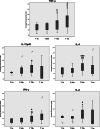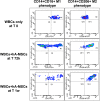Human Amnion-Derived Mesenchymal Stromal Cells in Cirrhotic Patients with Refractory Ascites: A Possible Anti-Inflammatory Therapy for Preventing Spontaneous Bacterial Peritonitis
- PMID: 33389680
- PMCID: PMC8166706
- DOI: 10.1007/s12015-020-10104-8
Human Amnion-Derived Mesenchymal Stromal Cells in Cirrhotic Patients with Refractory Ascites: A Possible Anti-Inflammatory Therapy for Preventing Spontaneous Bacterial Peritonitis
Abstract
Cirrhosis is associated with dysregulated immune cell activation and immune dysfunction. These conditions modify gut flora, facilitate bacterial translocation, and increase susceptibility to bacterial peritonitis and consequent systemic infections by dramatically affecting long-term patient survival. Human amnion-derived mesenchymal stromal cells (hA-MSCs) exert immunomodulatory potential benefit, and have the ability to modulate their actions, especially in situations requiring immune activation through mechanisms not fully understood. In this study, we aimed to investigate, in vitro, the immunostimulant or immunosuppressive effects of hA-MSCs on cellular components of ascitic fluid obtained from cirrhotic patients with refractory ascites. We found that hA-MSCs viability is not affected by ascitic fluid and, interestingly, hA-MSCs diminished the pro-inflammatory cytokine production, and promoted anti-inflammatory M2 macrophage polarization. Moreover, we found that there was no simultaneous significant decrease in the M1-like component, allowing a continual phagocytosis activity of macrophages and NK cells to restore a physiological condition. These data highlight the plasticity of hA-MSCs' immunomodulatory capacity, and pave the way to further understanding their role in conditions such as spontaneous bacterial peritonitis.
Keywords: Anti-inflammatory therapy; Ascites; Cirrhosis; Human amnion-derived mesenchymal stromal cells; M2 polarization; Perinatal tissues; Placenta; Spontaneous bacterial peritonitis.
Conflict of interest statement
The authors declare no conflicts of interest.
Figures









Similar articles
-
Human Amniotic MSC Response in LPS-Stimulated Ascites from Patients with Cirrhosis: FOXO1 Gene and Th17 Activation in Enhanced Antibacterial Activation.Int J Mol Sci. 2024 Feb 28;25(5):2801. doi: 10.3390/ijms25052801. Int J Mol Sci. 2024. PMID: 38474048 Free PMC article.
-
Human Amnion-Derived Mesenchymal Stromal Cells: A New Potential Treatment for Carbapenem-Resistant Enterobacterales in Decompensated Cirrhosis.Int J Mol Sci. 2022 Jan 13;23(2):857. doi: 10.3390/ijms23020857. Int J Mol Sci. 2022. PMID: 35055040 Free PMC article.
-
Long-term cannabinoid type 2 receptor agonist therapy decreases bacterial translocation in rats with cirrhosis and ascites.J Hepatol. 2014 Nov;61(5):1004-13. doi: 10.1016/j.jhep.2014.05.049. Epub 2014 Jun 19. J Hepatol. 2014. PMID: 24953022
-
Review article: spontaneous bacterial peritonitis--diagnosis, treatment and prevention.Aliment Pharmacol Ther. 2001 Dec;15(12):1851-9. doi: 10.1046/j.1365-2036.2001.01116.x. Aliment Pharmacol Ther. 2001. PMID: 11736714 Review.
-
Pharmacotherapy of ascites associated with cirrhosis.Drugs. 1992 Mar;43(3):316-32. doi: 10.2165/00003495-199243030-00003. Drugs. 1992. PMID: 1374317 Review.
Cited by
-
Human Amniotic MSC Response in LPS-Stimulated Ascites from Patients with Cirrhosis: FOXO1 Gene and Th17 Activation in Enhanced Antibacterial Activation.Int J Mol Sci. 2024 Feb 28;25(5):2801. doi: 10.3390/ijms25052801. Int J Mol Sci. 2024. PMID: 38474048 Free PMC article.
-
Alleviation of Severe Skin Insults Following High-Dose Irradiation with Isolated Human Fetal Placental Stromal Cells.Int J Mol Sci. 2022 Nov 1;23(21):13321. doi: 10.3390/ijms232113321. Int J Mol Sci. 2022. PMID: 36362110 Free PMC article.
-
Facing the Challenges in the COVID-19 Pandemic Era: From Standard Treatments to the Umbilical Cord-Derived Mesenchymal Stromal Cells as a New Therapeutic Strategy.Cells. 2023 Jun 19;12(12):1664. doi: 10.3390/cells12121664. Cells. 2023. PMID: 37371134 Free PMC article. Review.
-
The Truth Is Out There: Biological Features and Clinical Indications of Extracellular Vesicles from Human Perinatal Stem Cells.Cells. 2023 Sep 25;12(19):2347. doi: 10.3390/cells12192347. Cells. 2023. PMID: 37830562 Free PMC article. Review.
-
Human Amnion-Derived Mesenchymal Stromal Cells: A New Potential Treatment for Carbapenem-Resistant Enterobacterales in Decompensated Cirrhosis.Int J Mol Sci. 2022 Jan 13;23(2):857. doi: 10.3390/ijms23020857. Int J Mol Sci. 2022. PMID: 35055040 Free PMC article.
References
Publication types
MeSH terms
Substances
LinkOut - more resources
Full Text Sources
Other Literature Sources
Medical

